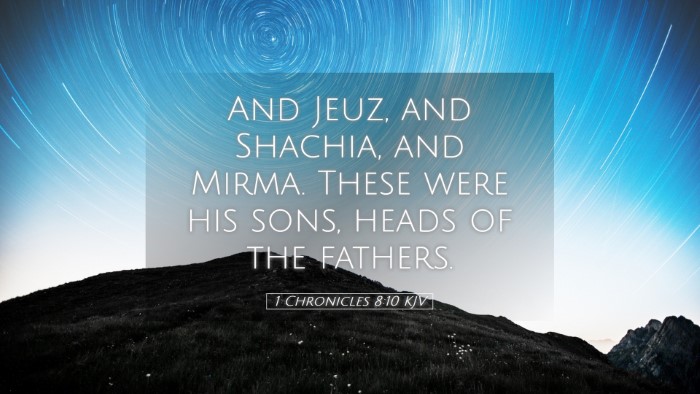Commentary on 1 Chronicles 8:10
Verse Text: "And Ezrahiah begat Ahitub, and Ahitub begat Ahijah."
Introduction
The genealogical records in 1 Chronicles serve not just as a historical account of lineage but also reflect God's covenantal faithfulness and purpose within Israel’s history. Among these names, we find 1 Chronicles 8:10, which explores the lineage leading to significant priestly figures. Understanding this verse within its broader context opens insights into the priestly structure in Israel and God's promise to His people.
Historical Context
The books of Chronicles were compiled after the Babylonian Exile, intended both to encourage the returning exiles and to remind them of their identity as God's chosen people. The emphasis on genealogy highlights the importance of maintaining a holy lineage, particularly in the priestly families. This verse, which lists a direct line through Ezrahiah to Ahijah, illustrates the continuity of priesthood that is crucial to worship and community integrity in post-exilic Israel.
Genealogical Significance
Matthew Henry's Insights: Henry emphasizes that genealogies in the Bible are meticulously detailed to demonstrate God's providence in preserving a remnant. Each name, though perhaps not instantly recognizable, contributes to the overarching narrative of divine faithfulness.
Albert Barnes' Commentary: Barnes points to the specific naming of Ahitub and Ahijah as those who played pivotal roles in the priestly duties. Ahitub is often thought to be significant in context, as his descendants continued a priestly lineage of service.
Adam Clarke's Observations: Clarke notes that the names mentioned are not just arbitrary but carry theological weight. Each successor in the line points toward God’s intention to maintain His priesthood through faithful leaders. He sees this lineage as an indication of God's continuous work among His people.
Theological Implications
- Covenantal Faithfulness: The lineage from Ezrahiah to Ahijah underscores God's commitment to His covenant. This genealogy acts as a reminder of God’s unwavering fidelity to His promises.
- Priesthood and Worship: The succession of priests from Ahitub to Ahijah is crucial for understanding the priestly system in Israel. It illustrates the continuation of sacred responsibilities over generations.
- Identity and Heritage: The chronicler’s focus on lineage serves to form and reaffirm the identity of the people of Israel post-exile, reminding them of their heritage and the importance of their roles in God’s redemptive plan.
Application for Today
The themes seen in 1 Chronicles 8:10 can be deeply applicable in contemporary settings for pastors, students, theologians, and Bible scholars. The realization that we stand in a spiritual lineage, as heirs of the promises given through Israel, enriches our understanding of our identity in Christ.
- Understanding Heritage: Just as the Israelites were reminded of their heritage, modern believers should reflect on their spiritual lineage and the faithfulness of God in their lives.
- Exemplifying Faithfulness: The importance of succession in faithful service to God serves as a leadership lesson for Christians today, understanding the call to mentor and disciple others in faith.
- Celebrating the Continuity of Faith: Recognizing the ongoing story of God's people throughout history encourages us to see ourselves in that narrative, connected to the past while looking forward to the future hope in Christ.
Conclusion
In conclusion, 1 Chronicles 8:10 encapsulates far more than just names; it signifies a profound truth about God’s unchanging nature, His faithfulness to His people, and the importance of priestly legacy within the community of faith. As we reflect on these insights, we are reminded of our role in God’s unfolding story and the critical responsibility we carry to pass on the faith to future generations.


